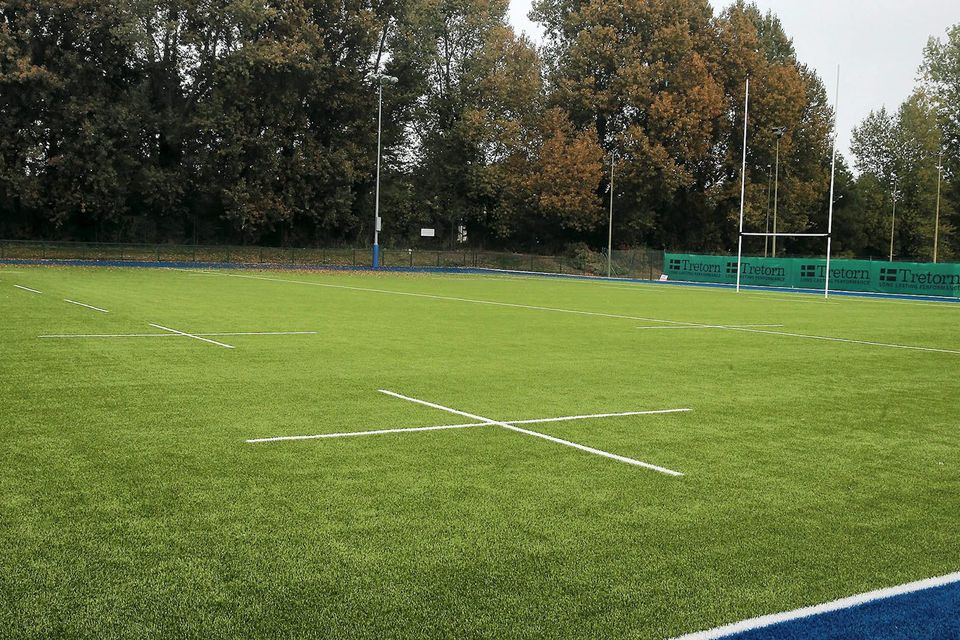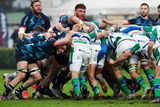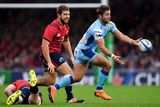Neil Francis: Welcome to Donnybrook's synthetic Field of Dreams
The 3G synthetic pitch in Donnybrook which can be used for 35-40 hours a week. Photo: Arthur Carron
Years ago I attended a Christian service in the UK. Gods appointed man made his play at the halfway stage.
"I have good news and bad news" he said. "The good news is we have enough money to pay for a new roof on the church. The bad news is its still in your pockets."
I have seen the future but it's going to cost. I went down to Donnybrook last Sunday to kick a ball around on the new state of the art synthetic pitch which was completed a few weeks ago on the back pitch and will be finished in about 10 days on the main pitch. In my crystal ball I see Capital expenditure, I see fundraising, I see schools and clubs buying these pitches, I see replication all over the country - this is the way forward.
The technical details are worthy of inspection. What has been laid is a 3G synthetic 'Rugger 65' spec surface. The topsoil from the original pitch has been stripped off and the field is geometrically flat - no hollows, dips or valleys. There are drainage channels and pipes inserted for a system that will clear 5cms of rain.
There is a 20mm clip on shock pad underneath and the carpet is realistic, pliable and has enough give in it to cushion players in contact. The four-metre rolls are stitched and glued together seamlessly. The product is supplied by SIS Surfaces and the contractor for the Leinster branch project is Pride Sports & Leisure. It is a fantastic product. David Fry, principal of Pride Sports & Leisure made a simple analogy for the pitch "the aspiration is for a soft July pitch all year long."
For all the lobbyists who campaigned for rugby to be played in the summer months - well you are half way there. When you see what now covers the Bective back pitch (a gluepot) and the Donnybrook main pitch (a dustbowl) you realise that the possibilities are endless. These pitches can be used 35-40 hours a week.
The Department of Sport chipped in €750,000 aware of the potential of not just the recognised rugby community but the opportunity for youths, community programmes and schools that have just begun formative programmes for rugby.
It also means that section A schools, Vinnie Murray teams, girls and women's rugby get to play in Donnybrook rather than shipping them out across the country to venues that don't hold much appeal for players, parents or supporters. Donnybrook is once again the field of dreams.
Unless the weather is really bad - the necessity for cancelling games is gone. The synthetic pitch can take frosts up to -20 degrees centigrade. If the RDS is frozen then Leinster can play the match in Donnybrook. Water-logged pitches are a thing of the past. You can play double or triple headers on the main pitch in Donnybrook at the drop of a hat. You don't even have to mark the pitch.
I brought a ball along last Sunday. I thought the bounce of the ball was true. The purists might argue that if the pitch is so uniform that all kicks might be too predictable. A traditional grass pitch with all its imperfections will cause any manner of unpredictable bounces. Grubber kicks especially get erratic jumps on the third or fourth hop which sometimes flummoxes defenders.
The ball's trajectory when it is pumped into the air and let bounce is still difficult to deal with - the surface being neither dull enough nor hard enough to cause either a wild variation or none at all. The rugby ball as it is designed to be is an object of unpredictability. The synthetic pitch does not change this.
The real benefit is that it forces you to play a better brand of rugby and because the pitch is mud and water free you can.
The stats say that the ball is in play longer on synthetic pitches because the pitch is not muddy or slippery. There are less scrums. There are far less collapsed scrummages.
Front rows don't lose their grip on engagement or when the pressure comes on. There are less handling errors because the ball doesn't have a coat of mud and moisture. It is a faster game because the surface doesn't give. Wingers or full-backs can be confident that they can run at full pace or when they cut back inside that their footing won't give way - like it does on a real grass pitch.
The corollary of all this is that the better, stronger teams who can play rugby will win more matches on a synthetic pitch. It is not hard to extrapolate meaningful facts from stats that I formulated about Saracens who have been using the exact same synthetic pitch at Allianz Park in London.
I haven't got a huge amount of regard for Saracens or their owner Nigel Wray but they should be commended for having the foresight to buy and install the pitch back in February 2013. In that season Saracens scored 533 points on the way to topping the group and winning the Aviva Premiership. Last season they topped the league in the regular season and scored 629 points - almost 100 points more.
They are sometimes hard to watch and used to play a conservative brand of rugby but read into this the change of style and the jump in points what you want.
Last season's Heineken Cup threw up a little nugget. Saracens played Connacht in the first round in Pool 3 and got out with their lives at 17-23 in the Sportsground. The return fixture saw Saracens annihilate Connacht by 64-6.
The match played in January, showed what happens when you play rugby as it is supposed to be played. Saracens kept the ball alive, rarely put the ball down and played at a pace that Connacht, used to mulching about in the Sportsground, couldn't live with. There were ironically more scrums in the return fixture (17) than at the sports ground (11) which is hard to reconcile.
As for the prime use of the Donnybrook pitch - schools rugby - it hasn't taken the big players long to react to what's going on. Blackrock College who would spend a fair amount of time playing cup matches in Donnybrook have got the wheels in motion to get exactly the same type of synthetic pitch put into its grounds.
There are many reasons for its forthcoming installation - prime amongst them is that they are going to be familiar with playing on a synthetic surface where the majority of their cup games are played. In my mind the bigger stronger schools that play a progressive and high tempo game will benefit. I would also suggest that the days of the fancied teams getting turned over on a mucky day will diminish greatly. You decide whether that is a good thing or not.
The Leinster branch reckons that their costs on maintaining the pitch in Donnybrook will be slashed by 50pc. We might even have some sand left on our beaches. The pitch only needs to be brushed once a week for God's sake.
Injuries are the unquantifiable factor with the pitch. The journal of sports science did mention the ACC injuries on these pitches 'were worthy of further study.' You go to war - you'll get casualties no matter what the terrain.
These pitches will spring up all over the country - the bad news is that a collection box is heading your way soon - pitches not roofs .















